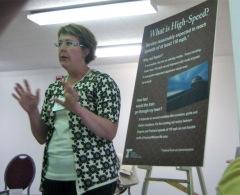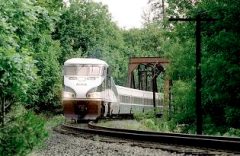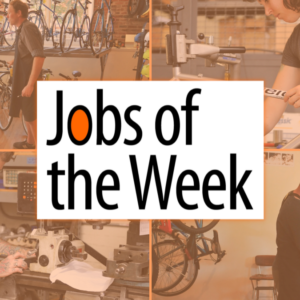
(Photo: Daniel Ronan)
The Obama Administration recently green-lighted money for development of a rail corridor between Eugene and Portland and the Oregon Department of Transportation (ODOT) is hosting a series of open houses to discuss the project.
I recently spoke with ODOT’s rail program study director Betsy Imholt and attended the open house in Eugene yesterday to learn more about how bikes might (or might not) fit into ODOT’s passenger rail plans.
“Now we have something to look for that is a little bolder than incremental improvements.”
— Betsy Imholt, ODOT
Imholt said that despite all the buzz about rail, it’s not new to ODOT. “A lot of people think that this is new, but we’ve been planning since the 1960s.” But now, with recent interest and investment from the US DOT, she added that, “we have something to look for that is a little bolder than incremental improvements.”
Imholt stressed that citizen involvement in the open houses and participation in the online survey is critical in shaping goals for the future high-speed rail in Oregon. “We have taken the railroad knowledge that we have and set draft service goals; we really don’t know if those are too ambitious or not ambitious enough,” Imholt says.

see a bike trail.
(Photo: ODOT)
Draft goals for the rail corridor include: reducing travel time from Eugene to Portland from two hours and thirty-five minutes to two hours, increasing on-time performance from 68 to 95 percent and increasing total daily round trips from two to six. Imholt stresses that these goals are in the draft phase. “The open houses and the survey are intended to give us feedback on these goals.” The goals will in turn shape the alignment of rail service in the Willamette Valley.
With regard to rail alignments, Imholt mentions that some citizens have advocated for a high-speed rail alignment along parts of I-5:
“Transportation connections, multimodal systems, and livability are important concepts, and an I-5 alignment will have a harder time reflecting a lot of these challenges. One benefit is the potential of faster speeds, however, the faster you go the less you stop, so informing the public of these trade offs is key.”
Also, Imholt added that an I-5 alignment could potentially limit bicycle and pedestrian connections in town centers, which highlights the importance of broad public participation.
As a sign of ODOT’s commitment to passenger rail, this past spring the agency used surplus funds from low bids on highway construction projects to purchase two new Talgo passenger trains. The trains will be equipped with baggage cars with a carrying capacity of up to 15 additional bikes per train.
Imholt says that the input from the survey responses received included many comments about bikes, suggesting that more comments would play a larger role in how bikes are considered in future service goals.
Open houses are being held across the Willamette Valley. Portland’s open house tonight from 4:30 to 6:30 at 123 NW Flanders in downtown Portland. Learn more at ODOT’s Passenger Rail website.
— For more on Obama’s high speed rail plans and how bikes might factor into them, read our story from February.






Thanks for reading.
BikePortland has served this community with independent community journalism since 2005. We rely on subscriptions from readers like you to survive. Your financial support is vital in keeping this valuable resource alive and well.
Please subscribe today to strengthen and expand our work.
I’ve ridden Talgo trains in Europe. They are very nice, but they won’t reach their full potential here unless the rail lines are substantially upgraded to allow them to travel at speed.
Increasing speed should not be our goal. Shaving half an hour off the Eugene to Portland trip does not represent the kind of change we need in a world about to run out of cheap oil; where we’ve already run out of atmosphere.
Ivan Illich and Wolfgang Sachs are just two scholars who have explored the fallacy of pursuing ever greater speed.
http://www.ranprieur.com/readings/illichcars.html
http://www.ucpress.edu/book.php?isbn=9780520068780
http://en.wikipedia.org/wiki/Wolfgang_Sachs
I took the survey just now. Only my opinion here, but we may be pushing our luck asking for a bike lane next to the train tracks. Plus, from past experience, I know that riding next to a train is uncomfortably loud.
As long as they continue to allow bikes on the new-improved and faster trains, I’m good.
9watts: Increasing speed makes (and on-time performance) makes train travel more competitive with car travel, which in my opinion is a good thing. Just in terms of environmental impact, providing an incentive to people to take the train up and down the valley instead of driving would be a huge plus. Most people won’t do that unless there’s something in it for them, getting there more quickly by train than by car would help.
9watts:
Sorry, but without increased speed, there’s simply no incentive for potential passengers to take the train instead of driving. It has to be much more convenient (some combination of faster, cheaper, better connections) before people will switch in any great number. And greater numbers of passengers feed back into making it all viable, and in taking the maximum number of cars off the road.
However, any train stations that leave passengers in the middle of nowhere do not serve the passenger rail network of the future. So, an I-5 alignment might work between cities, but not in them.
Two big factors hold American train speeds down so much with respect to the rest of the world: shared tracks with freight carriers; and level crossings. If we cannot eliminate both of these, no amount of drivetrain or suspension technology will allow safe high speed travel. Rights of way are so much harder to get now, when for most of the 20th century, tracks have been torn up and ROWs sold off. It’ll be expensive to reverse now, but more so in the future, when we’ll need good rail that much more.
Increased speed is also necessary to make rail more competitive with commercial aviation. Granted, this is for longer distance trips than Portland to Eugene, but it is essential to improving rail service along the entire west coast corridor(e.g. from Vancouver BC to San Diego CA). If you do the research, you will find that the airline industry has lobbied heavily in the past against high speed rail in the US.
There is no need for Willamette Valley trains to be faster than automobiles to be competitive. It only has to be nearly as fast.
Train service could provide things that a driver cannot do, such as a light meal (sandwich cart), Internet access, time to read, study, watch a DVD, or even nap. And the traveler more likely arrives relaxed, fresh, and ready to get on with activities and not worn down and irritated by hassling for hours with traffic.
I’m not sure how long it will take for railroads to get the amenities in place, but this is what will drive their future. When the time being a passenger is no longer a time-out from the rest of one’s life, then rail will start its second renaissance.
I spent my childhood taking trains everywhere in Germany. They were very nice–much like what is probably planned/hoped for here in the Willamette Valley. I also now take the Coast Starlight (Amtrak’s N-S train) to California when I need to go that way. Though the two systems are very different, both have their charms. Speeding up what we have now will be very capital intensive, expensive, consume vast quantities of materials, and it isn’t at all clear what the benefit will be, or who will benefit, or whether the benefit is commensurate with the various costs. While it is almost conceivable that we could emulate parts of Europe’s train network, in terms of speed, reliability, amenities if we invested untold sums, I believe we’ve missed our chance to go down that road.
We’re going to have to learn to travel much less, not more and faster and with greater convenience. All travel over long distances uses fossil fuels these days, and that is not about to change. What is about to change is the ease with which we (who can afford to) overcome these distances. Our sense of entitlement to the kind of transport infrastructure that makes it possible to do what airports and high speed rail networks promise has to change.
rail at any speed is a much more efficient people mover than either private automobiles or commercial airplanes.
Agreed, BURR, but since we’re talking about infrastructure here, I’d rather see ODOT start thinking and talking about how we’re going to get around without oil, gas and electricity. Infrastructure is pretty long lived. Did I mention that the US Military now expects peak oil to occur by 2015?
http://www.guardian.co.uk/business/2010/apr/11/peak-oil-production-supply
I take no pleasure in raining on the party, but don’t see the point in building out infrastructure that no one is going to be able to use.
Thanks Jonathan…this is great news (and I will do the survey)…I am very glad to hear the ODOT is finally starting to pull its weight in the passenger rail area for this region…I take the train 95% of the the time i go north on trips from Van WA…and only 5% south bound … due to the less than opportune timetable (twice a day does not allow one to do business in Eugene and get home at night or make most morning meetings by rail) and more delays. But with 6 trips a day you can start thinking of the southbound train option.
And 15 bike hooks per train – that is a vast improvement on bike access vs. the old 5 bikes. Bravo…
Please also consider adding smart bike parking at ALL OR rail stations (www.bikelink.com) or better yet full bikestations (or Bikestation Modules at secondary stations). Also think about services you find at stations in Portland, Vancouver and Seattle – like carsharing (Zipcar), And services that onee sees at airports: smart baggage lockers, hotel kiosks, etc. And how about making ti easier to pick up a ticket: adding Amtrak ticket kiosks in town (not just at stations), etc.
PS. When Talgo delivers the trains – make sure they have…wifi…and a DVD movie player and not a VCR….the existing Talgos still have VCRs…that are now not working…or have not been upgraded.
Not too many places are getting this federal rail funding, but when the money became available ODOT was prepared with a great project.
Go rail! Go bicyles! Go ODOT!
Not too many places are getting this federal rail funding, but when the money became available ODOT was prepared with a great project.
I was a the meeting, and the ODOT rail director (Kelly …) said that the money for the new trains came from unused HIGHWAY money allocated from the stimulus. They have only received 8 million in rail money so far, and all of that is going to the portion of the Seattle-Portland route that is in Oregon. In fact she said quite explicitly that they were not prepared to receive rail money, and need to do a lot of planning before anything can actually be built.
Hello GLV. Just as a clarification, I believe the highway funds that went to purchasing the new Talgo trains came from the lower construction bids for highway transportation projects due to the economic downturn. The only amount of stimulus money allocated to anything rail related in Oregon was the $8 million given to restoration projects at Portland’s Union Station.
9watts:
“We’re going to have to learn to travel much less, not more and faster and with greater convenience.”
[…]
“I’d rather see ODOT start thinking and talking about how we’re going to get around without oil, gas and electricity.”
Since it would seem you argue that electricity is not sustainable, I can only assume you pine over the modes of travel from past centuries (including the bicycle which tops about 15-30kmh).
While I too have romantic visions of slow travel (horse, boat, bicycle,hiking)…it’s rather naïve to consider it possible for a modern society to achieve, on a scale of any significance (modern people want speed). Why not focus on modern, practical (read: achievable) goals like increased bicycle, trolleybus and train infrastructure?
Many cyclists here use electrically-assisted bicycles to achieve greater distances and faster travel times.
You must also be familiar with Germany’s EEG scheme, which at present, will bring Germany’s clean energy percentage of renewable, clean energy up to 27% by 2020, no doubt powering at least some of their electrified train network.
I’d also like to refer you to Chapter 20 in David MacKay’s excellent book “Sustainable Energy – without the hot air”[1] he is a Professor in the Department of Physics at the University of Cambridge…he argues that “trains manage to achieve outstanding
efficiency without travelling slowly, and without having a low weight
per person.” […] “by exploiting
the principle of small frontal area per person”.
[1]http://www.inference.phy.cam.ac.uk/withouthotair/c20/page_119.shtml
I am a big fan of intermodal transport, and like trains a lot for the reasons you list. I’m in favor of improving our existing train infrastructure too, to offer more reliable service, better accommodation of bicycles, etc. My gripe was with the need for and assumed desirability of greater speed. While this is a familiar goal, this to me is anathema for two reasons: (1) it is inherently unequal; those who get to pay to go ever faster impede the rest of us (see Ivan Illich), and (2) Peak Oil and Climate Change both preclude continuing down this road of ever greater speed.